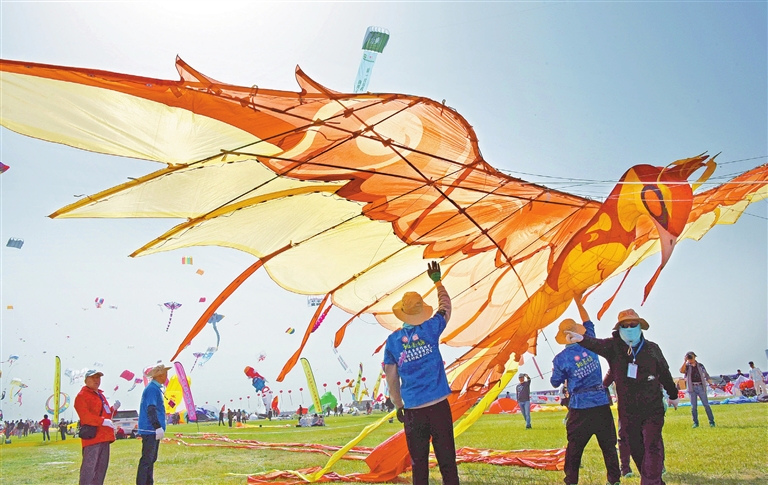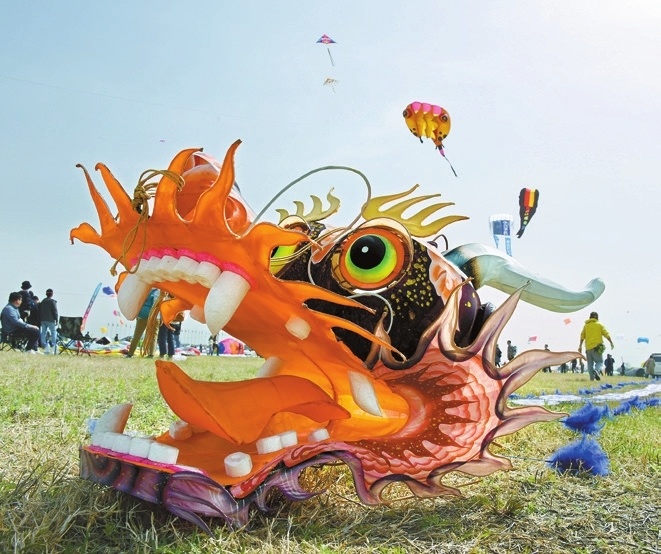

AS spring winds blew, a huge crowd gathered in a field in Weifang, Shandong Province, looking to the skies in awe. Overhead, a sea of colorful kites in a multitude of sizes danced — their designs featuring high-speed trains, dragons, whales, peonies and cartoon characters, among others. The 40th Weifang International Kite Festival attracted more than 150 teams from 59 countries and regions, who sent their kites skyward for the opening ceremony April 15. The festival lasts about a month. Wang Yongxun, an experienced kite maker in Weifang, attended the festival with kites designed as different types of vegetables, including Chinese cabbages, carrots and green radishes. “Weifang is known nationwide for its vegetables, so we designed vegetable kites to salute our hometown,” said Wang, who also brought another type of kite. Displaying the kite, Wang said: “This is a traditional fixed-wing kite, to which we added a mechanical windmill in the center. When the wind blows, the windmill rotates, resulting in two model cockerels moving as though they are fighting each other.” Stanislav Kolbintsev, who comes from Russia, was attending the festival for the first time. He brought a kite bearing the image of a traditional Chinese bird painting. It took him more than six months to make the kite. “I am not good at sewing, so I made the kite slowly in my free time, paying great attention to detail. It’s interesting to compare the kites from different countries at the festival.” In the festival’s innovative section, Zhang Huagang and more than 20 fellow team members flew a 150-meter-long kite designed as a high-speed train. Comprising a locomotive and 50 carriages, it took the team about three months to complete the kite. Wind on the opening day was perfect for Andreas Agren, who brought a light-wind kite designed as a Viking ship from his home country Sweden. In one area of the field, a 300-meter-long kite with 150 strings attracted crowds of photographers. It was so long that it frequently became entangled with other kites, forcing its flyer, Ma Liping, who comes from Inner Mongolia, to ground it. A set of 14 kites featuring a ballet dance design also attracted considerable attention. Each kite, which is two meters long and nearly one meter wide, is controlled by four strings. Flown by 14 people from Handan, Hebei Province, Shenyang, Liaoning Province, and Qingdao, Shandong Province, the kites were deftly controlled as the team members tugged at the strings to form different patterns in the air. Team member Bai Xuedong said, “It takes a year to master the basic skills needed to fly the kites in a choreographed way that ensures the strings don’t become tangled. “Flying kites is a good way to stay in shape. If the weather permits, the team, which comprises retirees, practices for several hours a day.” The event’s organizing committee said the festival attracted more than 100,000 people on the opening day. Sobraj Al Akand, who comes from Bangladesh, said: “We saw traditional kites, such as those designed like a dragon to represent China, and some really high-tech designs. Companies are also using kites to advertise themselves, which is a really nice concept.” Listed as a national intangible cultural heritage in 2006, kites have been flown in Weifang, known as the world’s kite capital, for about 2,400 years. Legend has it that ancient Chinese philosopher Mozi, who was known for his craftsmanship, made the first kite in what is now present-day Weifang. He is said to have spent three years making a wooden kite, but on the first day it flew, it fell to the ground and broke. An ancient book states that kites were invented by Lu Ban (507-440 B.C.), a renowned carpenter, craftsman and engineer. His statue stands in front of the Weifang World Kite Museum. The first session of Weifang International Kite Festival attracted kite lovers from 11 countries and regions, including the United States, Australia, the United Kingdom, the Netherlands, Canada, Japan, New Zealand and Singapore, in 1984. Kite-flying has also become a popular pursuit in the city, with locals frequently seen flying their kites in squares and in fields set aside for the activity. (China Daily) | 
